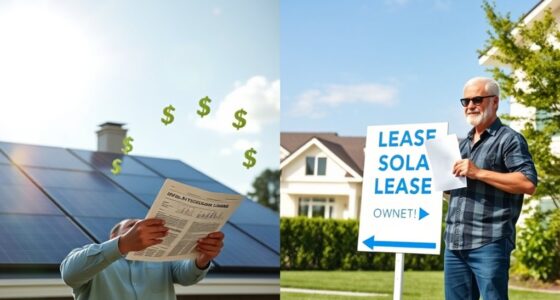When purchasing land for a tiny house, expect unexpected costs like land lease fees, utility hookup charges, and permit expenses that can surprise you. Hidden fees might include land surveys, environmental assessments, zoning variances, and ongoing property taxes. Plus, there could be extra charges for parking, land improvements, and insurance. Staying aware of these potential hidden costs helps you plan better, and you’ll find more details if you continue exploring this vital information.
Key Takeaways
- Unexpected land closing fees may include title searches, escrow services, and recording fees that vary by location.
- Zoning and permit application costs can add thousands if special variances or environmental assessments are required.
- Additional charges for land surveys and soil tests are often overlooked but essential for legal and construction purposes.
- Utility connection fees, such as sewer, water, and electrical hookups, can significantly increase overall closing expenses.
- Hidden costs like property taxes, insurance, and transfer taxes may surprise buyers during the closing process.
Hidden Land Purchase and Lease Expenses
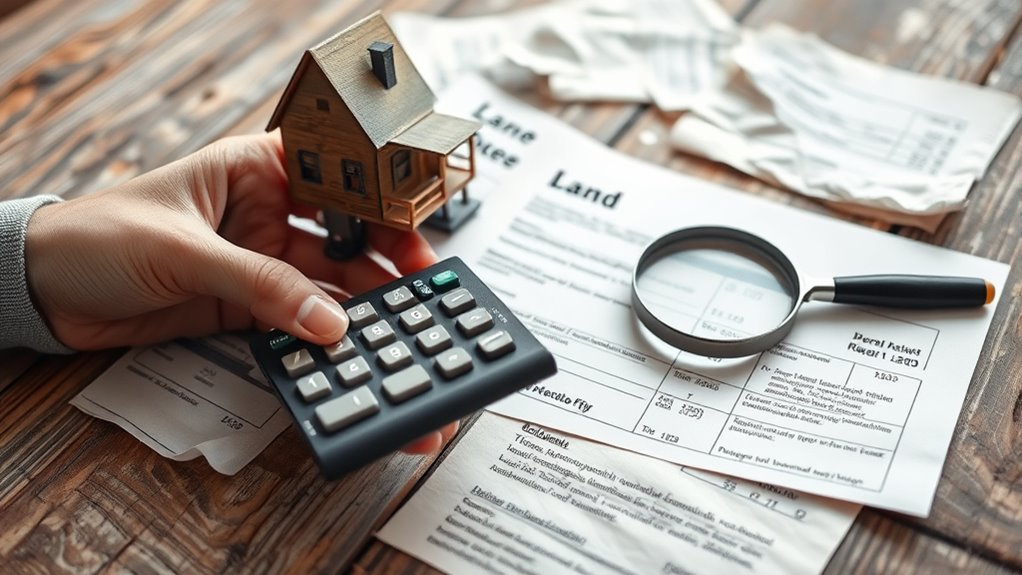
When purchasing or leasing land for your tiny house, hidden expenses can quickly add up beyond the initial price. Lease agreements vary widely, with monthly costs ranging from $200 to over $1,500, depending on the contract type. Month-to-month leases offer flexibility but tend to be more expensive, while annual leases often cost less but may have strict terms. Be aware that some landowners impose extra charges for waste disposal, parking permits, or shared amenities. Upfront fees like security deposits and application costs can also surprise you. Additionally, property taxes might be passed on to you, and insurance could be required, adding ongoing costs. These hidden expenses can notably impact your overall budget, so it’s essential to review lease terms carefully and factor in potential extra charges before committing. Understanding local regulations and zoning laws can help prevent unexpected legal costs and ensure your tiny house remains compliant. Being aware of Ring Security Cameras can also help protect your investment and property.
Unexpected Utility Hookup Costs

Unexpected utility hookup costs can catch you off guard, especially if you’re unprepared for the expenses involved in connecting your tiny house to essential services. Plumbing installation can range from $1,180 to $4,000, depending on whether you DIY or hire professionals. Sewer hookups might cost over $10,000 if there’s no existing connection, which can be a shocking expense. Electrical hookups vary but often include installation fees, and adding mini-split HVAC systems can cost between $1,500 and $4,000. Water hookups may require connecting to municipal lines or drilling a well, with well costs being significant. Additionally, connection fees and deposits can surprise you. If your land is remote, expect trenching and extended pipe or cable runs, increasing costs further. Fathers often emphasize the importance of planning ahead for these unexpected expenses to ensure a smooth transition to your new tiny home.
Building Permits and Land Improvement Fees
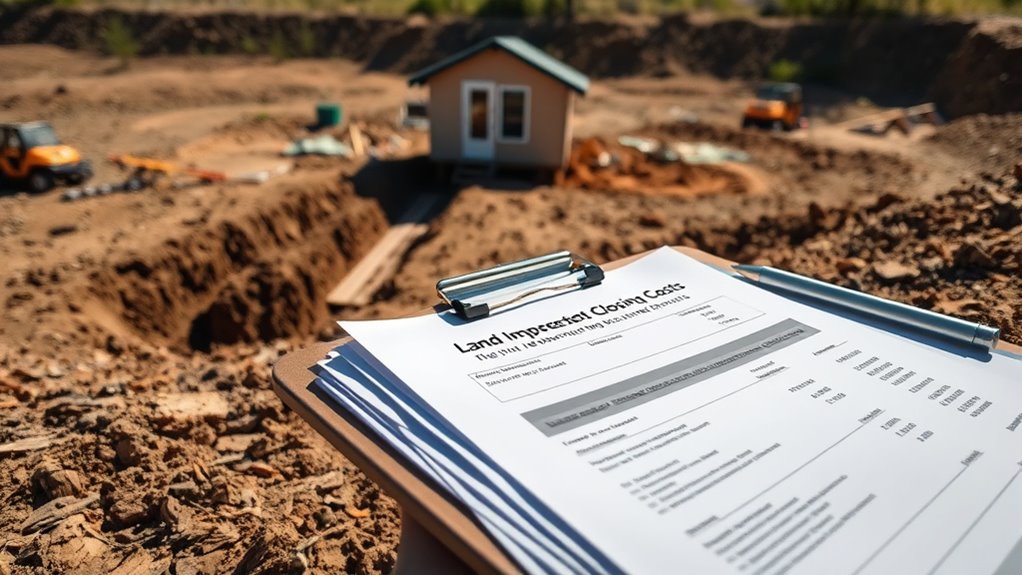
Getting the right permits can considerably impact your tiny house project, and costs vary widely based on location and house type. The application process involves different steps and fees, depending on local rules and land conditions. Understanding land preparation expenses and permit costs upfront helps you better plan your overall budget. Permit fees can range from a few hundred to several thousand dollars, so researching local regulations early can help you avoid unexpected expenses later. Additionally, considering zoning requirements and potential land improvements can further influence your total costs.
Permit Application Process
Applying for permits to build and land your tiny house involves submitting detailed documentation and maneuvering local approval processes. You’ll need to provide thorough architectural plans, including structural calculations and specifications for plumbing, electrical, and mechanical systems. Zoning verification is required to confirm your land allows tiny houses. You might also need proof of compliance with state building codes, like the ICCBC and Appendix Q. Common permits include building, electrical, plumbing, and mechanical permits, with some areas requiring grading or septic permits based on land conditions. The review process can be lengthy, involving multiple plan revisions and inspections. Once approved, you’ll receive a building permit, allowing construction to begin. After completing inspections, you may obtain occupancy or certification approvals, confirming your tiny house’s safety and legality. Additionally, understanding projector technology can help in designing a suitable home cinema setup for your tiny house.
Cost Variability Factors
The costs for building permits and land improvements can vary widely depending on your location and project specifics. Permit fees typically range from $300 to $3,100, influenced by local regulations and project complexity. Urban areas with stricter codes tend to charge higher fees, while rural regions are usually cheaper. Some states, like Colorado, restrict certain fee components, affecting total costs. Permits may cover multiple inspections—electrical, plumbing, structural—adding to variability. For land improvements, utility hookup costs can range from $750 to $25,000, depending on infrastructure access. Land survey fees generally fall between $400 and $800, with additional charges for impact fees or zoning changes. Understanding regional differences in building regulations can help you better estimate your total expenses for tiny-house land development. Additionally, local government rules often influence how much you’ll pay for these services, making it essential to research specific regional requirements.
Land Preparation Expenses
How much you’ll spend on land preparation for your tiny house depends largely on location and site conditions. Building permits typically cost between $900 and $2,500, with some areas requiring detailed plans and inspections that can add to expenses. Land improvement fees, like grading, utility installation, and road access, can range from a few thousand to over $25,000, especially in remote or challenging terrains. Environmental assessments and zoning compliance can further increase costs, and special conditions, such as permafrost or soil instability, demand extra work. Here’s a snapshot of typical expenses:
| Expense Type | Cost Range | Key Consideration |
|---|---|---|
| Building Permits | $900 – $2,500 | Local regulations and complexity |
| Land Grading | $5,000 – $15,000 | Site topography and soil quality |
| Utility Installation | $3,000 – $10,000 | Water, sewer, and electricity access |
| Road Access | $2,000 – $8,000 | Remote locations, terrain challenges |
| Environmental Fees | Varies | Environmental assessments needed |
Additionally, understanding land preparation expenses can help you better plan your budget and avoid unexpected costs.
Zoning and Legal Compliance Expenses
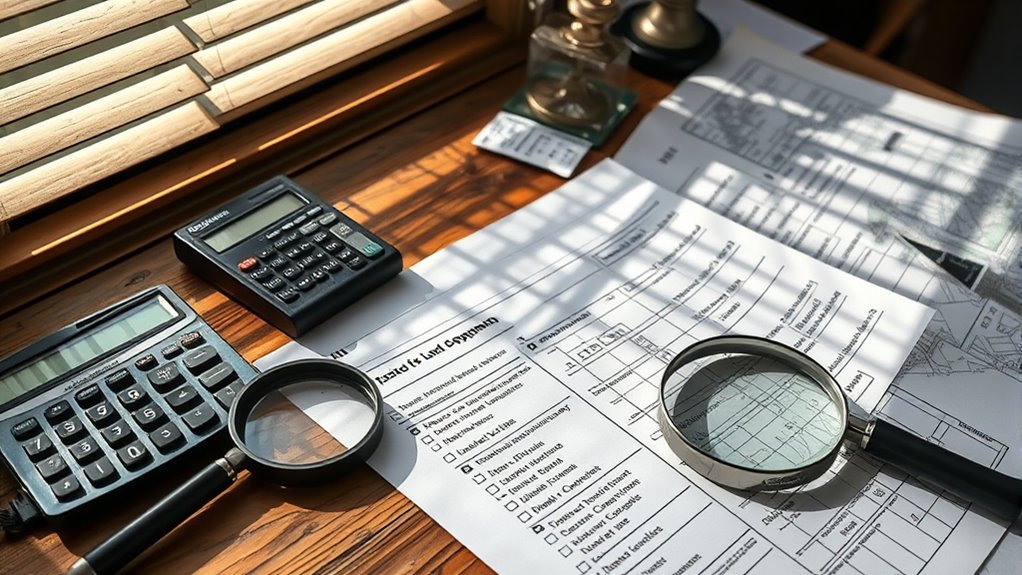
Zoning and legal compliance costs can substantially impact your tiny-house land purchase. You’ll need to take into account permitting fees, zoning restrictions, and possible variances to meet local regulations. Understanding these expenses upfront helps you avoid surprises and ensures your tiny home project stays on track. Regulatory frameworks provide guidance on standardizing requirements and streamlining processes to reduce unforeseen costs. Additionally, creative practice can help you explore flexible solutions when navigating complex zoning rules.
Permitting and Licensing Fees
Permitting and licensing fees can substantially impact your tiny-house project, with costs that vary based on location and project complexity. In urban areas, fees tend to be higher due to stricter regulations, while rural areas may charge only a few hundred dollars. The type of permits needed—such as building, electrical, plumbing, or environmental—also influences the total cost. Additionally, understanding local zoning laws can help determine whether certain permits are required for your specific property regulations and codes. Here’s what you might encounter:
- Building permits, which can range from $500 to over $3,100 depending on local rules.
- Electrical and plumbing permits, adding to the overall expense if systems are complex.
- Environmental permits, required in environmentally sensitive areas, further increasing costs.
Understanding these fees upfront helps you budget accurately and avoid surprises during your tiny-house journey.
Zoning Restrictions and Variances
Understanding local zoning restrictions and the need for variances is essential before purchasing land for your tiny house. Zoning laws control land use, density, and building size, often making it challenging to place tiny homes in certain areas. Some jurisdictions see tiny houses as temporary or substandard, restricting them in residential zones, while others require amendments or variances. Applying for variances or conditional use permits (CUPs) involves costs, time, and interactions with planning departments, sometimes requiring community efforts. You may need legal help to navigate zoning codes, which adds to expenses. Delays or denied applications can increase holding costs or risk fines. Being proactive, consulting officials early, and understanding local requirements can help manage these zoning-related expenses and avoid surprises at closing. Additionally, understanding floating on water options or alternative zoning classifications may provide more flexibility for tiny house placement.
Additional Land Surveys and Environmental Assessments

When preparing to build your tiny house, arranging additional land surveys and environmental assessments is a crucial step that can influence your project’s timeline and costs. These evaluations ensure the land is suitable and free from hidden issues. Land surveys can range from $200 to over $5,500 depending on property size, terrain, and survey type, such as boundary or ALTA surveys. Environmental assessments, often required for new builds, typically cost $1,500 to $5,000+ and examine land contamination, soil, and groundwater. Additional fees may include boundary adjustments, missing records, or remote property access, which can increase costs and cause delays. Incorporating Vetted electric bike kits can provide eco-friendly transportation options during land exploration and project setup. Early planning and shopping around can help you manage expenses and avoid unexpected charges.
Ongoing Parking and Land Rental Fees
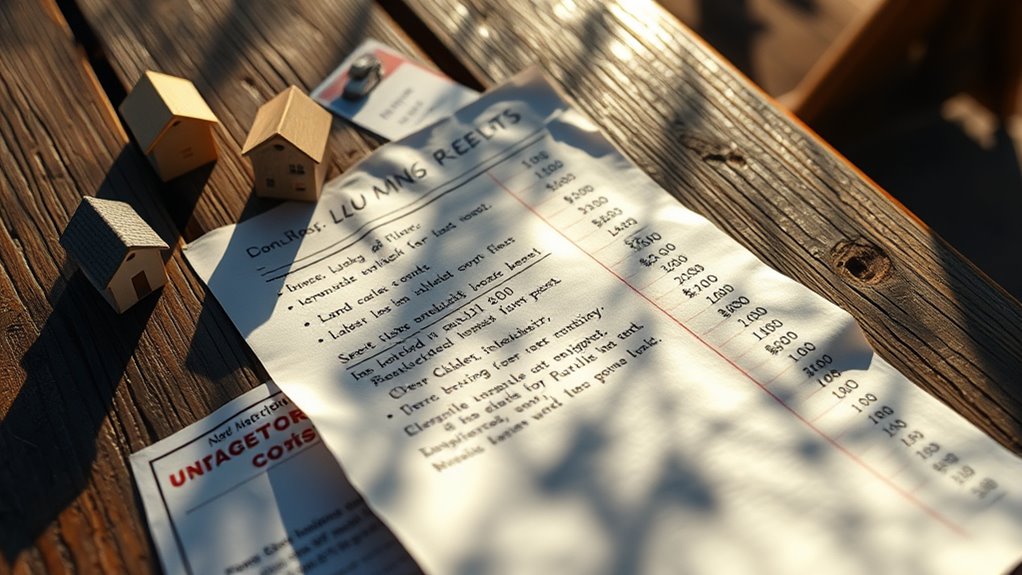
Ongoing parking and land rental fees are essential costs to contemplate when planning your tiny house setup, especially since they can vary widely based on location and amenities. Monthly rental costs typically range from $200 to $1,500, with urban and coastal areas demanding higher prices due to infrastructure and hookups. Rural land usually costs less but may lack utilities like water and power, increasing setup expenses. Lease agreements vary: month-to-month leases cost $300-$800, annual leases $200-$600 per month, and community lot fees can reach $400-$1,200 monthly. Many urban spots include utilities, while rural sites often require off-grid solutions. Be aware that additional fees for waste disposal, shared amenities, or lease penalties can further impact your ongoing costs.
Surprising Legal and Inspection Charges
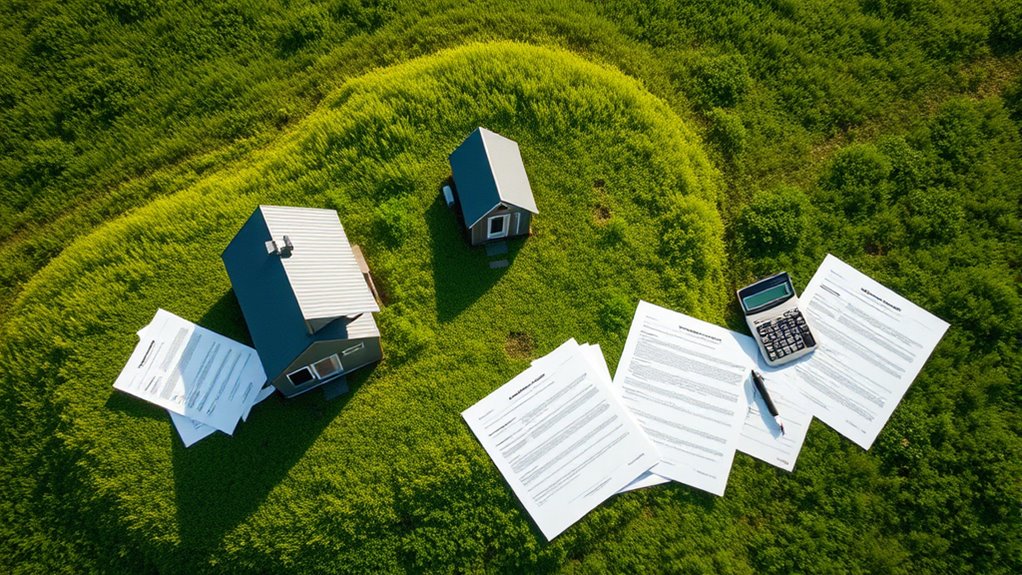
Legal and inspection charges can catch tiny house buyers off guard, adding unexpected costs to the land purchase process. These fees often surprise buyers who aren’t prepared for the full scope of legal and regulatory expenses. Property surveys, costing between $100 and $600, are essential for defining land boundaries and avoiding future disputes. Some municipalities require these before completing the sale or issuing permits. Building permits, averaging around $1,350, can be a significant expense, especially if multiple permits for electrical, plumbing, or structural work are needed. Failure to get permits risks fines or removal. Inspection fees for soil testing, environmental hazards, or site suitability can cost a few hundred dollars. Skipping these inspections might lead to costly issues later. Regulatory compliance costs can also include fees for zoning variances or special use permits, which are sometimes necessary for tiny houses placed on land in certain areas.
Loan-Related Closing and Insurance Fees
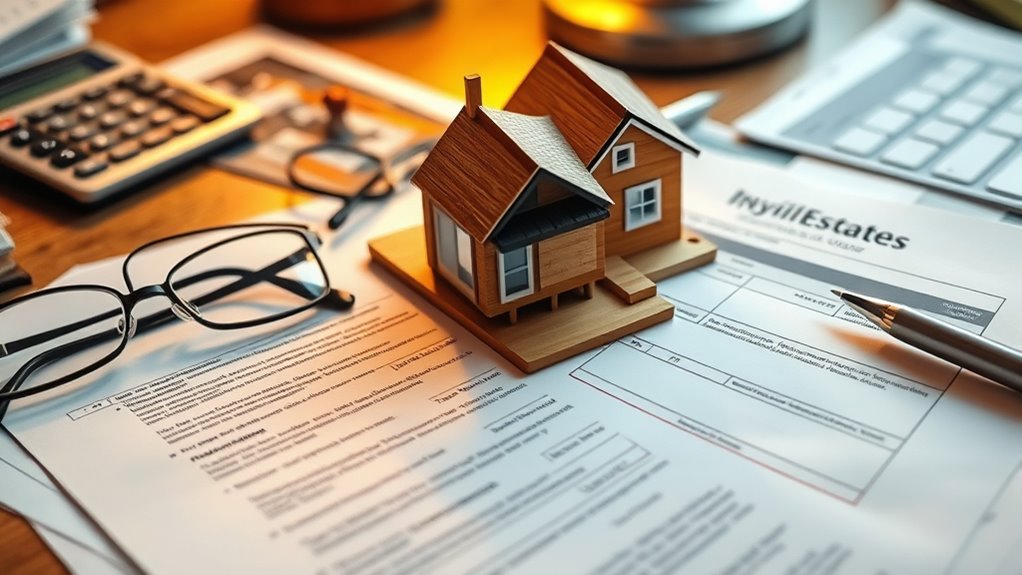
Are you aware of the various loan-related closing and insurance fees that can considerably impact the total cost of buying tiny-house land? When you secure a land loan, expect to pay origination and processing fees, which typically range from 0.5% to 1.5% of the loan amount and cover administrative costs. Title insurance and land appraisals are also common, costing between $300 and $1,500 combined, and are necessary to verify ownership and land value. You might choose to buy discount points to lower your interest rate, increasing initial costs but saving money over time. Additionally, lenders may require hazard or liability insurance, and in some cases, mortgage insurance, adding to your upfront and ongoing expenses. These fees are essential to consider in your overall budget for tiny-house land.
Property Taxes and Ongoing Land Use Costs
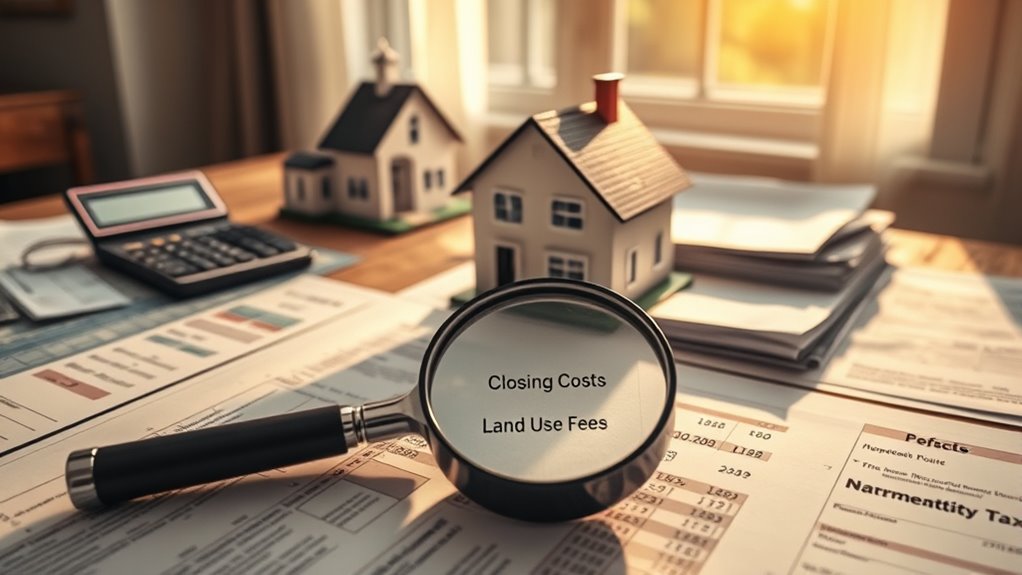
Property taxes on tiny-house land can vary widely depending on where you buy, and these costs can substantially affect your long-term budget. The tax rate depends on the state, local jurisdiction, and land value assessments. Here are three key points to consider:
Property tax rates for tiny-house land vary by location, impacting your long-term budget.
- Tax Rates and Assessments: Rates range from 0.32% in Hawaii to over 2% in New Jersey, with assessments based on land value and improvements, including tiny houses if classified as permanent structures. Tax assessments can fluctuate annually, impacting your future tax obligations.
- Local Jurisdictions: Cities, counties, and districts like school boards or utility districts can add extra fees, increasing your annual tax bill.
- Ongoing Costs: Beyond taxes, expect fees for water, sewer, road maintenance, or community associations, which vary depending on your location and land use classification.
Understanding these factors helps you budget for long-term land ownership costs.
Frequently Asked Questions
Are There Hidden Costs When Leasing Tiny House Land?
When you lease tiny house land, hidden costs can catch you off guard. You might face extra fees for utilities, installation, and permits, which can add up quickly. Be aware of potential charges for shared community amenities, maintenance, and early termination penalties. Always review lease agreements carefully to understand what’s included and what might incur additional expenses, so you avoid surprises that could strain your budget.
How Much Do Utility Hookups Typically Add to Total Costs?
Think of utility hookups as the hidden treasure in your tiny house adventure. They can add anywhere from $1,180 to over $20,000, depending on your land and needs. Electricity, water, and sewer connections often surprise owners with higher costs, especially in remote areas. Budget for these expenses early, as they’re essential to turn your tiny house dream into a comfortable, functional reality.
What Permits Are Required for Tiny House Land Development?
When developing tiny house land, you’ll need several permits. You must get zoning and land use permits to make sure your property allows tiny houses, and building permits to meet local codes. Additionally, health and safety permits are necessary for plumbing, water, and fire safety. Don’t forget environmental permits for impact assessments and utility connection permits for electricity, water, and sewage. Securing these permits guarantees your project complies with local regulations and avoids costly fines.
Do Zoning Laws Impact Tiny House Land Costs?
Zoning laws definitely impact tiny house land costs. They can restrict where you build, requiring permits or variances that add expenses. If zoning allows tiny houses, you might access existing infrastructure, reducing costs. But strict restrictions or community opposition can drive up land prices or limit options. By understanding local zoning, you can find affordable land and avoid unexpected fees, making your tiny house project more budget-friendly.
What Are the Long-Term Land Use Fees Beyond Initial Closing?
You might think your land costs stop at the purchase, but surprise! Long-term land use fees keep coming. You’ll face ongoing property taxes, utility bills, and maintenance costs that creep up over time. Community fees and environmental assessments can hit your wallet unexpectedly. Even zoning compliance and legal fees for lease renewals may surprise you. So, plan ahead—your tiny house adventure involves more than just the initial investment.
Conclusion
So, before you plunge into tiny-house land buying, be prepared for these hidden costs—they can sneak up on you faster than a tornado! From unexpected fees to ongoing land expenses, it’s easy to underestimate what’s involved. Do your homework, budget extra, and stay vigilant. With a little planning, you’ll avoid surprises and make your tiny-home dream a reality without it feeling like you’re trying to tame a wild storm.
I’m Theodore, and I love tiny houses. In fact, I’m the author of Tiny House 43, a book about tiny houses that are also tree houses. I think they’re magical places where imaginations can run wild and adventures are just waiting to happen.
While tree houses are often associated with childhood, they can be the perfect adult retreat. They offer a cozy space to relax and unwind, surrounded by nature. And since they’re typically built on stilts or raised platforms, they offer stunning views that traditional homes simply can’t match.
If you’re looking for a unique and romantic getaway, a tree house tiny house might just be the perfect option.



